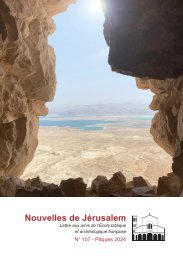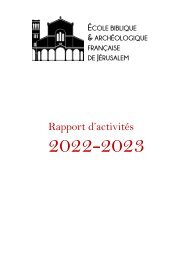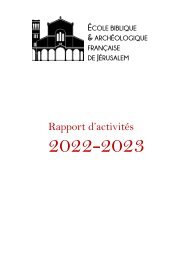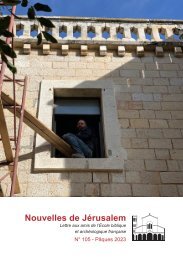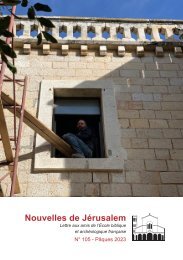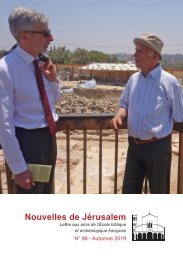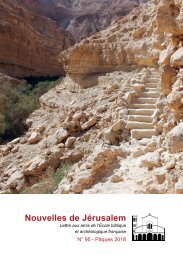NOUVELLES DE JÉRUSALEM - Automne 2017
Les Nouvelles de Jérusalem sont une revue d'informations de l'École biblique et archéologique française de Jérusalem, 2 à 3 fois par an, elles donnent un aperçu des travaux en cours en exégèse comme en archéologie, ici à Jérusalem. En voici le deuxième numéro couleurs en ligne. Les articles alternent français et anglais. The Nouvelles de Jérusalem is an information review of the École Biblique et Archéologique française de Jérusalem, 2-3 times a year, they give an overview of the work in progress in both exegesis and archeology, here in Jerusalem. Here is the second color edition online. Articles are sometimes in French sometimes in English.
Les Nouvelles de Jérusalem sont une revue d'informations de l'École biblique et archéologique française de Jérusalem, 2 à 3 fois par an, elles donnent un aperçu des travaux en cours en exégèse comme en archéologie, ici à Jérusalem. En voici le deuxième numéro couleurs en ligne. Les articles alternent français et anglais.
The Nouvelles de Jérusalem is an information review of the École Biblique et Archéologique française de Jérusalem, 2-3 times a year, they give an overview of the work in progress in both exegesis and archeology, here in Jerusalem. Here is the second color edition online. Articles are sometimes in French sometimes in English.
Create successful ePaper yourself
Turn your PDF publications into a flip-book with our unique Google optimized e-Paper software.
Bible<br />
Translating the Book of Isaiah into Mauritian<br />
Creole: Opportunities and Emerging Questions<br />
Fr. Laurent Rivet is a priest, native<br />
from the Island of Mauritius. He was<br />
student at the École biblique during<br />
the last academic year, ending his<br />
studies at the Università Gregoriana.<br />
The Biblical Society of Mauritius<br />
asked me to participate in the Old<br />
Testament translation project by<br />
working on the Book of Isaiah. In<br />
my creolophone parish in Mauritius,<br />
I had sometimes experienced<br />
the joyful astonishment of my parishioners<br />
hearing, during Mass,<br />
the liturgical readings in Creole.<br />
I knew that I was embarking on a<br />
demanding intellectual task. From<br />
my working desk in Jerusalem I<br />
remembered St Jerome, the patron<br />
saint of translators who lived only<br />
a few kilometres away and spent<br />
thirty difficult years working on the<br />
Vulgate! Somehow I would be able<br />
to help my people to have a better<br />
understanding of God who was<br />
now talking their mother tongue!<br />
The syntatic difficulty<br />
Mauritian Creole is probably<br />
amongst the newest languages<br />
in the world. It was created some<br />
300 years ago by Afro-Malagasy<br />
slaves who, listening to their masters’<br />
French, simultaneously tried<br />
to speak it and to resist it. Today,<br />
Mauritian Creole is the mother<br />
tongue of 85% of the population.<br />
However, it has long remained an<br />
oral language. For ideological and<br />
political reasons, its orthography<br />
was fixed and it has been taught at<br />
school only since 2007. The New<br />
Testament was translated only five<br />
years ago. Thus, Creole linguistic<br />
studies are quite new and only a<br />
few publications and translations<br />
have been made in Creole, with<br />
written poetry slowly emerging.<br />
One can easily suppose that the first<br />
difficulty of translating Hebrew<br />
poetry to Creole would be a syntactic<br />
one. Hebrew verses, generally<br />
composed of two repeated affirmations,<br />
usually use elliptic forms of<br />
expression such that the verb in the<br />
second part of the verse is most of<br />
the time omitted. For example, in<br />
Is 60:19b, the verb היה – to be – is<br />
used only once for both “YHWH<br />
being your everlasting light” and<br />
“God being your splendour”. The<br />
use of such elliptic forms is not very<br />
common in Creole and can obscure<br />
the meaning of a verse. The verse<br />
repetition phenomenon opens us<br />
to another challenge often met by<br />
translators: the lexico-semantic<br />
field. The two parts of the verse are<br />
rarely linked by a mere repetition<br />
but rather by a rhetoric of intensification.<br />
If רוא – light can be translated<br />
in Creole, its intensive partner<br />
הראפת – splendour can be only<br />
be rendered by leaving the “light”<br />
spectrum to give “beauty” or “glory”.<br />
Such examples can be multiplied<br />
all through the book. Talking<br />
of a field in biblical language is<br />
not really a metaphor. The prophet<br />
would often use agricultural and<br />
biological references to deliver his<br />
message: in their semi-desert area,<br />
the fauna and flora are not at all<br />
the same as on a tropical island!<br />
Therefore, Mauritian Creole’s lexicon<br />
does not correspond to the Hebrew<br />
one in this particular aspect.<br />
Another challenge of translating<br />
from Hebrew is the rendering of<br />
theological anthropomorphism.<br />
When in Is 60:13b, Isaiah speaks<br />
of the “place of the feet [of God]”<br />
to indicate the place where he<br />
stands; or in Is 9:11, when he talks<br />
of the “nose [of God] which is not<br />
turned” for “the anger which is not<br />
spent”, can we afford such leaps<br />
without impoverishing the metaphorical<br />
specificity of Hebraic<br />
theological expression? The same<br />
issue is encountered for idiomatic<br />
expressions: shall the covenant still<br />
be תרכ – cut or simply “made”?<br />
Are dynamic translations more<br />
appropriate though they be a bit<br />
anachronistic: in Is 65:3 the brick<br />
in the garden on which incense is<br />
burned is strangely similar to what<br />
we call in Creole “Garden guardian<br />
– gardyn lakour”. In this case, can<br />
6 7<br />
Lettre aux amis de l’ÉBAF - N° 94 - <strong>Automne</strong> <strong>2017</strong>




